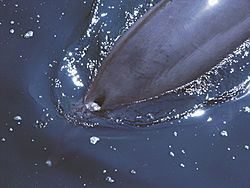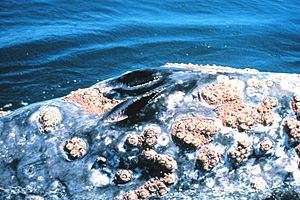Blowhole facts for kids


A blowhole is like a special nose for some amazing ocean animals, especially whales and dolphins! It's a hole right on top of their head that they use to breathe air. Imagine having your nose on top of your head – that's what a blowhole is for them!
Contents
Blowholes: Whales' Amazing Noses
Blowholes are super important for whales and dolphins because they live in water but need to breathe air, just like us. This special opening is actually very similar to the nostrils we have. Over many, many years, the nostrils of these marine mammals slowly moved to the top of their heads. This makes it much easier for them to breathe when they come to the surface of the ocean.
How Whales Breathe
When a whale reaches the surface of the water, it pushes air out of its blowhole very strongly. This air is released into the colder air above the water. When warm, moist air from the whale meets the cold air, the water vapor in the breath turns into tiny water droplets. This creates a visible spray, which is called the blow. It looks like a white splash and can often be seen from far away! Sometimes, the splash is also caused by water that was sitting on top of the blowhole.
Making Sounds Underwater
Just below the blowhole, whales have special air sacs. These sacs help whales make sounds for talking to each other. For toothed whales, like dolphins, these air sacs are also used for echolocation. Echolocation is like using sound waves to "see" things around them in the water. They fill these air sacs with air, then release it to make sounds, a bit like letting air out of a balloon.
When whales dive deep underwater, a special plug called a nasal plug covers the passage to the blowhole. This keeps water out. The muscles that control this plug relax when they are underwater. But when the whale needs to breathe again, these muscles tighten. This opens the blowhole, allowing the whale to breathe out and then breathe in fresh air.
Different Kinds of Blowholes
Not all whales have the same kind of blowhole!
- Baleen whales (like humpback whales) have two blowholes. These are usually shaped like a "V" on top of their head.
- Toothed whales (like dolphins and sperm whales) have only one blowhole.
For example, the sperm whale, which is a toothed whale, has its single blowhole a little to the left side of the front of its head. This blowhole is actually its left nostril. Its right nostril is still there inside, but it doesn't open to the outside.
Why Whales Can't Choke
A whale's windpipe (called the trachea) only connects to its blowhole. This means whales cannot breathe through their mouths. Because of this special design, there's no way for food to accidentally go into their lungs. This is why whales don't have a gag reflex, which is what makes us cough or gag if something goes down the wrong pipe. It's a very clever way for them to stay safe while eating and breathing in the ocean!

